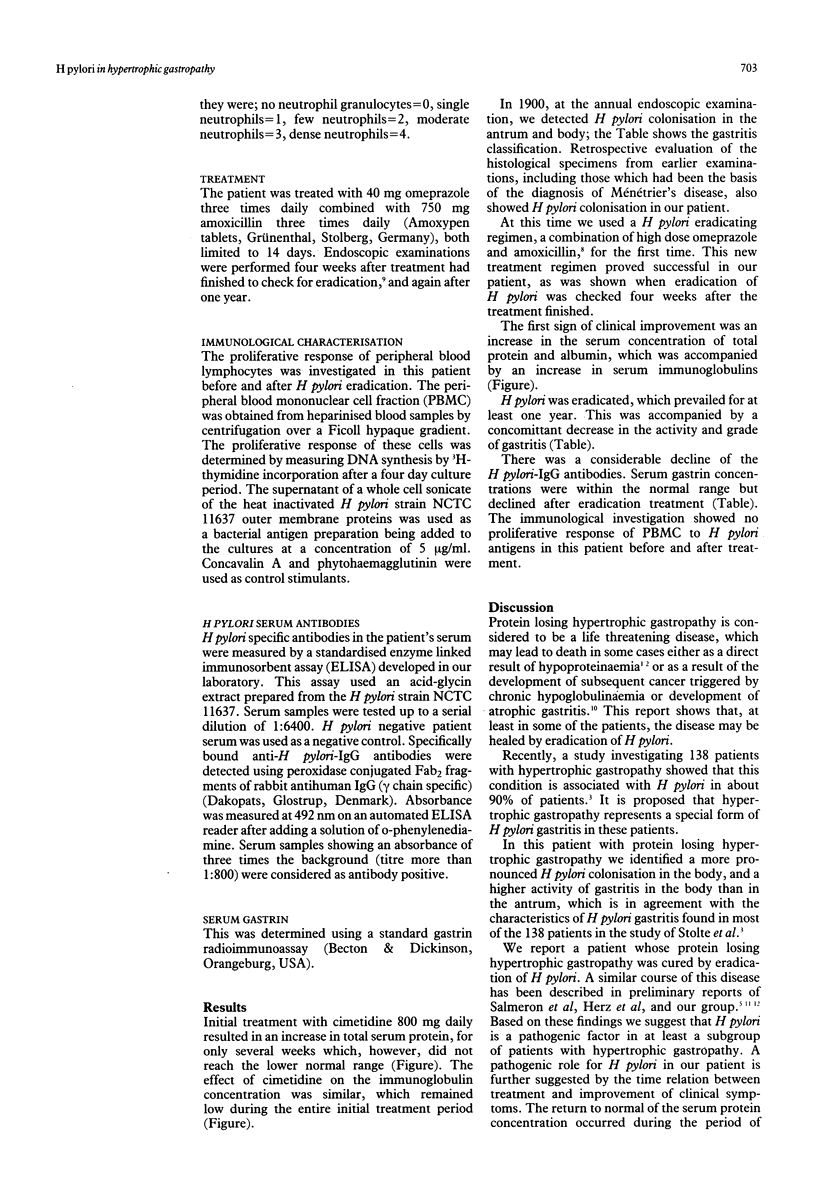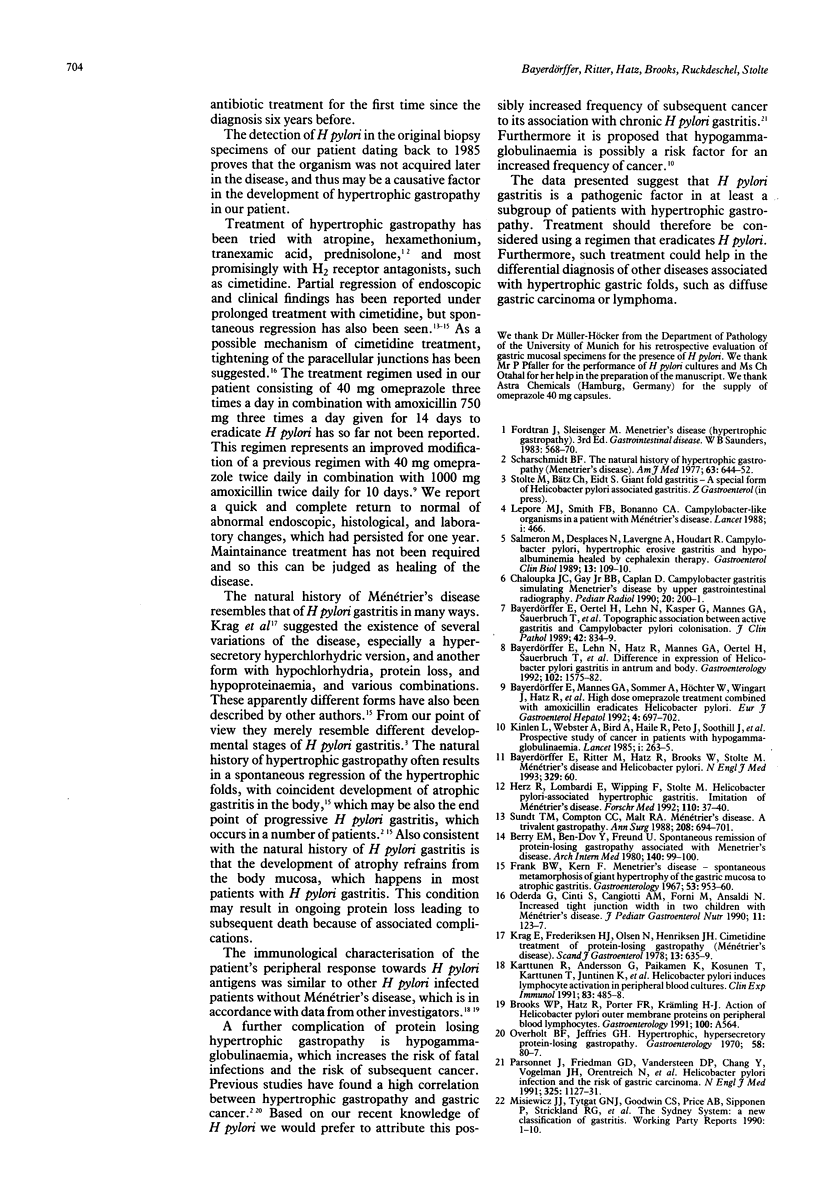Abstract
Hypertrophic gastropathy--that is, Ménétrier's disease--was found, in a retrospective analysis, to be associated with Helicobacter pylori in more than 90% of patients. It is proposed that hypertrophic gastropathy represents a special form of H pylori gastritis in these patients. A case is described of a 28 year old woman with Ménétrier's disease associated with proved protein loss from the stomach. Treatment with cimetidine for more than three years had little benefit when colonisation by H pylori was detected. Density of H pylori colonisation and activity of gastritis, which was also present in the first biopsy specimens taken five years ago, were more pronounced in the body than in the antrum, which is in agreement with the characteristics of H pylori gastritis found in other cases with Ménétrier's disease. A 14 day antibacterial treatment course with 750 mg amoxicillin three times a day combined with 40 mg omeprazole three times a day was started in April 1991. This resulted in eradication of H pylori and the return to normal of giant folds and the mucosal histology. Serum protein concentrations returned to normal within six weeks and remained normal at two endoscopies during a two year follow up. This case report suggests that a subgroup of the patients with Ménétrier's disease may be healed by the eradication of H pylori.
Full text
PDF



Selected References
These references are in PubMed. This may not be the complete list of references from this article.
- Bayerdörffer E., Lehn N., Hatz R., Mannes G. A., Oertel H., Sauerbruch T., Stolte M. Difference in expression of Helicobacter pylori gastritis in antrum and body. Gastroenterology. 1992 May;102(5):1575–1582. doi: 10.1016/0016-5085(92)91716-h. [DOI] [PubMed] [Google Scholar]
- Bayerdörffer E., Oertel H., Lehn N., Kasper G., Mannes G. A., Sauerbruch T., Stolte M. Topographic association between active gastritis and Campylobacter pylori colonisation. J Clin Pathol. 1989 Aug;42(8):834–839. doi: 10.1136/jcp.42.8.834. [DOI] [PMC free article] [PubMed] [Google Scholar]
- Bayerdörffer E., Ritter M. M., Hatz R., Brooks W., Stolte M. Ménétrier's disease and Helicobacter pylori. N Engl J Med. 1993 Jul 1;329(1):60–60. doi: 10.1056/nejm199307013290116. [DOI] [PubMed] [Google Scholar]
- Berry E. M., Ben-Dov Y., Freund U. Spontaneous remission of protein-losing gastropathy associated with Menetrier's disease. A plea for conservative management. Arch Intern Med. 1980 Jan;140(1):99–100. [PubMed] [Google Scholar]
- Chaloupka J. C., Gay B. B., Jr, Caplan D. Campylobacter gastritis simulating Menetrier's disease by upper gastrointestinal radiography. Pediatr Radiol. 1990;20(3):200–201. doi: 10.1007/BF02012977. [DOI] [PubMed] [Google Scholar]
- Frank B. W., Kern F., Jr Menetrier's disease. Spontaneous metamorphosis of giant hypertrophy of the gastric mucosa to atrophic gastritis. Gastroenterology. 1967 Dec;53(6):953–960. [PubMed] [Google Scholar]
- Herz R., Lombardi E., Wipping F., Stolte M. Helicobacter-pylori-assoziierte Riesenfaltengastritis. Imitation eines Morbus Ménétrier. Fortschr Med. 1992 Feb 10;110(4):37–40. [PubMed] [Google Scholar]
- Kinlen L. J., Webster A. D., Bird A. G., Haile R., Peto J., Soothill J. F., Thompson R. A. Prospective study of cancer in patients with hypogammaglobulinaemia. Lancet. 1985 Feb 2;1(8423):263–266. doi: 10.1016/s0140-6736(85)91037-2. [DOI] [PubMed] [Google Scholar]
- Lepore M. J., Smith F. B., Bonanno C. A. Campylobacter-like organisms in patient with Ménétrier's disease. Lancet. 1988 Feb 27;1(8583):466–466. doi: 10.1016/s0140-6736(88)91251-2. [DOI] [PubMed] [Google Scholar]
- Oderda G., Cinti S., Cangiotti A. M., Forni M., Ansaldi N. Increased tight junction width in two children with Ménétrier's disease. J Pediatr Gastroenterol Nutr. 1990 Jul;11(1):123–127. doi: 10.1097/00005176-199007000-00024. [DOI] [PubMed] [Google Scholar]
- Overholt B. F., Jeffries G. H. Hypertrophic, hypersecretory protein-losing gastropathy. Gastroenterology. 1970 Jan;58(1):80–87. [PubMed] [Google Scholar]
- Parsonnet J., Friedman G. D., Vandersteen D. P., Chang Y., Vogelman J. H., Orentreich N., Sibley R. K. Helicobacter pylori infection and the risk of gastric carcinoma. N Engl J Med. 1991 Oct 17;325(16):1127–1131. doi: 10.1056/NEJM199110173251603. [DOI] [PubMed] [Google Scholar]
- Salmeron M., Desplaces N., Lavergne A., Houdart R. Campylobacter pylori, hypertrophic erosive gastritis and hypoalbuminemia healed by cephalexin therapy. Gastroenterol Clin Biol. 1989 Jan;13(1):109–110. [PubMed] [Google Scholar]
- Scharschmidt B. F. The natural history of hypertrophic gastrophy (Menetrier's disease). Report of a case with 16 year follow-up and review of 120 cases from the literature. Am J Med. 1977 Oct;63(4):644–652. doi: 10.1016/0002-9343(77)90210-8. [DOI] [PubMed] [Google Scholar]
- Sundt T. M., 3rd, Compton C. C., Malt R. A. Ménétrier's disease. A trivalent gastropathy. Ann Surg. 1988 Dec;208(6):694–701. doi: 10.1097/00000658-198812000-00004. [DOI] [PMC free article] [PubMed] [Google Scholar]


